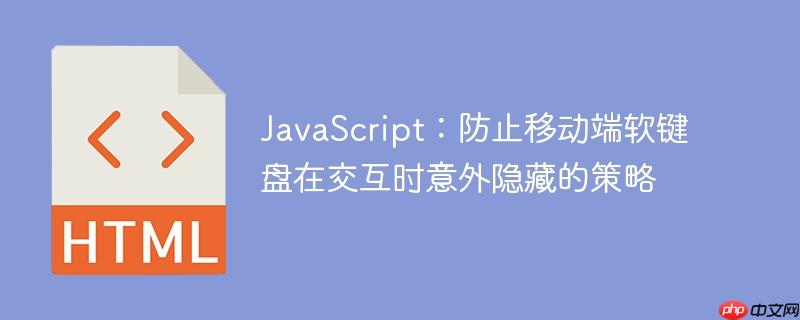
在移动端web开发中,用户体验的一个常见痛点是软键盘的行为。当用户在一个输入框(如<input>或<textarea>)中输入内容时,软键盘会弹出。然而,如果用户随后点击了页面上的非输入元素,例如一个工具栏按钮(如“tab”键、格式化按钮等),浏览器通常会认为输入框失去了焦点(blur事件),从而自动隐藏软键盘。这种反复的键盘弹出和隐藏会严重中断用户的工作流,降低操作效率。
解决这一问题的核心思路是利用JavaScript在用户点击非输入元素后,立即将焦点重新设置回原有的输入框。通过调用输入框元素的focus()方法,我们可以强制浏览器保持该输入框的激活状态,从而阻止软键盘的自动隐藏。
为了实现这一功能,我们需要识别两个关键元素:
以下是一个具体的代码示例,演示如何防止在点击“插入Tab”按钮时软键盘隐藏:
<!DOCTYPE html>
<html lang="zh-CN">
<head>
<meta charset="UTF-8">
<meta name="viewport" content="width=device-width, initial-scale=1.0">
<title>防止移动端键盘隐藏</title>
<style>
body {
font-family: Arial, sans-serif;
margin: 20px;
background-color: #f4f4f4;
}
#myEditor {
width: 90%;
height: 150px;
padding: 10px;
border: 1px solid #ccc;
border-radius: 4px;
font-size: 16px;
margin-bottom: 10px;
box-sizing: border-box;
}
.toolbar-button {
padding: 8px 15px;
margin-right: 5px;
border: none;
background-color: #007bff;
color: white;
border-radius: 4px;
cursor: pointer;
font-size: 14px;
}
.toolbar-button:hover {
background-color: #0056b3;
}
</style>
</head>
<body>
<h1>移动端键盘保持可见性示例</h1>
<textarea id="myEditor" placeholder="请在此输入内容..."></textarea>
<div>
<button id="tabButton" class="toolbar-button">插入Tab</button>
<button id="boldButton" class="toolbar-button">加粗</button>
<button id="anotherButton" class="toolbar-button">其他操作</button>
</div>
<script>
document.addEventListener('DOMContentLoaded', () => {
const editor = document.getElementById('myEditor');
const tabButton = document.getElementById('tabButton');
const boldButton = document.getElementById('boldButton');
const anotherButton = document.getElementById('anotherButton');
// 核心逻辑:在点击按钮时重新聚焦编辑器
const keepKeyboardVisible = (event) => {
// 阻止按钮的默认行为,例如提交表单或触发其他可能导致焦点丢失的事件
event.preventDefault();
// 重新聚焦输入框,确保键盘保持可见
editor.focus();
// 如果需要,可以在这里添加按钮的特定功能
console.log(`按钮 "${event.target.textContent}" 被点击了,键盘保持可见。`);
};
tabButton.addEventListener('click', (event) => {
keepKeyboardVisible(event);
// 示例:在当前光标位置插入一个Tab字符
const start = editor.selectionStart;
const end = editor.selectionEnd;
const value = editor.value;
editor.value = value.substring(0, start) + '\t' + value.substring(end);
// 重新设置光标位置
editor.selectionStart = editor.selectionEnd = start + 1;
});
boldButton.addEventListener('click', (event) => {
keepKeyboardVisible(event);
// 示例:对选中文字进行加粗处理(此处仅为示意,实际富文本编辑会更复杂)
const start = editor.selectionStart;
const end = editor.selectionEnd;
if (start !== end) {
const selectedText = editor.value.substring(start, end);
const newValue = editor.value.substring(0, start) + `**${selectedText}**` + editor.value.substring(end);
editor.value = newValue;
editor.selectionStart = start + 2; // 调整光标位置
editor.selectionEnd = end + 2;
}
});
anotherButton.addEventListener('click', keepKeyboardVisible);
// 页面加载时自动聚焦(可选)
// editor.focus();
});
</script>
</body>
</html>在上述代码中,keepKeyboardVisible函数封装了核心逻辑:event.preventDefault()用于阻止按钮的默认行为,而editor.focus()则强制输入框重新获得焦点。我们将这个函数绑定到所有不希望导致键盘隐藏的按钮的click事件上。
立即学习“Java免费学习笔记(深入)”;
通过在非输入元素的点击事件中,利用JavaScript的focus()方法将焦点重新设置回输入框,我们可以有效地防止移动端软键盘在用户交互时意外隐藏。这一简洁而强大的技术能够显著提升移动Web应用的用户体验,尤其是在需要频繁与输入框和辅助工具栏交互的场景中。正确地应用此策略,能够为用户提供一个更加流畅和高效的输入环境。
以上就是JavaScript:防止移动端软键盘在交互时意外隐藏的策略的详细内容,更多请关注php中文网其它相关文章!

每个人都需要一台速度更快、更稳定的 PC。随着时间的推移,垃圾文件、旧注册表数据和不必要的后台进程会占用资源并降低性能。幸运的是,许多工具可以让 Windows 保持平稳运行。




Copyright 2014-2025 https://www.php.cn/ All Rights Reserved | php.cn | 湘ICP备2023035733号